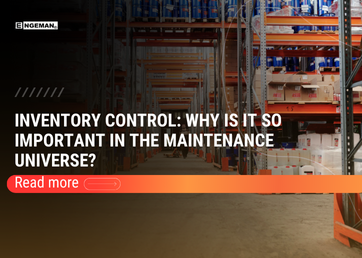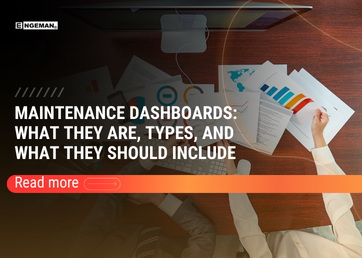Contents
- What are the types of maintenance?
- Corrective Maintenance
- Preventive Maintenance
- Predictive Maintenance
- Detective Maintenance
- Prescriptive Maintenance
- Maintenance Engineering
- What are the trends for maintenance?
- Industrial Internet of Things (IIoT)
- Cloud computing
- Augmented reality (AR)
- How can technology assist in industrial maintenance?
Maintenance can be understood as all actions that are performed to maintain or conserve certain assets. In order for this asset to remain in perfect condition, maintenance uses strategies to correct when a failure occurs. Bringing to the industrial scene, these actions contribute to the correct operation of machines and equipment in order to avoid unexpected stops.
If we make a timeline listing the evolution of maintenance, we will see that it needs to adapt to technological advances and with the increasingly growing demands of the market. Managers who want to keep their company at prominent levels, seek to update themselves and bring news, always following trends.
In this article, we will talk briefly about the types of maintenance, how they are applied in the industry and also about the main trends so that your company does not get behind in the face of so many technological advances. Follow us to the end!
What are the types of maintenance?
There are several types of maintenance, and each of them has a way of application and a certain time to be carried out. Each company has particularities and needs to understand well the types of maintenance to know which will be the most suitable for your organization.
Sometimes we verify that, among maintenance workers, there is still some confusion about the nomenclature used to define the types of maintenance. This is because of:
- Adoption of different names from one industry to another;
- Neologism itself sometimes derived from translations of some foreign languages;
- Dissemination of the names of the types of maintenance, not always well explained or understood, but that wins the local or private routine.
Therefore, names may even vary, but the concept should be well understood. The firm conceptualization allows the choice of the most convenient type for a particular equipment, installation, or system.
We consider the following classification as very suitable according to the types of maintenance:
- Corrective Maintenance;
- Preventive Maintenance;
- Predictive Maintenance;
- Detective Maintenance;
- Prescriptive Maintenance;
- Maintenance Engineering.
Let’s look below, how each type of maintenance can be characterized.
Corrective Maintenance
The Corrective Maintenance is an acting due failure correction or less than expected performance.
Corrective comes from the word corrected. Corrective Maintenance is also known as Reactive Maintenance, because it addresses machine problems only when they appear, as a way to react to the problem. Corrective Maintenance can be divided into two classes:
- Unplanned Corrective Maintenance – Failure correction in a random way, that is, it is the failure correction or less than expected performance after the event has occurred. This type of maintenance implies high costs because it causes production losses; the damage to equipment is higher. When there is only corrective, maintenance is commanded by the equipment;
- Planned Corrective Maintenance – is the correction that is made due to a predictive, detectable monitoring, or even by the management decision to operate until the failure. This type of maintenance is planned. Everything that is planned is always cheaper, safer, and faster.
In some industries these two types of corrective maintenance are known as Predictable Corrective Maintenance and Unpredictable Corrective Maintenance.
Preventive Maintenance
Preventive Maintenance is performed to reduce or avoid failures or a fall in performance, submitting a planning based on Defined TIME Intervals.
One of the secrets of a good preventive is to determine the time intervals. As, in doubt, we tend to be more conservative, the intervals are usually smaller than necessary, downtime and unnecessary spare parts replacement.
Therefore, preventive has great application in installations or equipment whose failure can cause disasters or risks to the environment; complex and/or continuous-operation systems.
Because Preventative Maintenance is based on time intervals, it is known as Time-Based Maintenance – TBM
Predictive Maintenance
Predictive Maintenance is a set of activities to monitor variables or parameters that indicate the equipment performance, in a systematic way, aiming to define the need or not for intervention.
When the intervention, as a result of predictive monitoring, is carried out, we are doing a PLANNED CORRECTIVE MAINTENANCE.
This type of maintenance is known as Condition Based Maintenance (CBM). That is to allow equipment to operate longer, and intervention takes place based on data and not in conceptions.
Consequently, some companies adopt a classification where Preventive includes Time-Based Maintenance and Condition Based Maintenance, so Predictive would be a part of Preventive. We chose to keep it separate in view of the different characteristics between them.
Detective Maintenance
Detective Maintenance is the action performed in protection systems or commands to find hidden failures or what is not perceptive to operating and maintenance workers. A classic example is the circuit that controls the entrance of a generator in a hospital. If there is a power interruption and the circuit has a failure the generator does not enter.
Prescriptive Maintenance
Prescriptive Maintenance uses the latest technologies to make measurements and analyses remotely and in real time. In this model the technician does not need to go to the field to make a meticulous evaluation.
It could be like predictive maintenance, but the prescriptive maintenance goes beyond, because it does not limit just to execute recommendations, it acts. It will provide a diagnostic, submit a work order, and still generate reports after the operator carried out the repairs, for example. This is all accomplished through integrated systems and with the use of Artificial Intelligence.
Maintenance Engineering
Maintenance Engineering is the set of activities that allow reliability to increase and guarantee the availability. It is to stop fixing and living with chronic problems to improve standards and be systematic.
Normally who is putting out fire, using the unplanned corrective maintenance, will not have time to do maintenance engineering. But you may have time to continue putting out fire and getting terrible results. It is important that it changes, integrating preventive and predictive maintenance to do maintenance engineering.
What are the trends for maintenance?
The current trends, analyzed by the companies that are benchmark, indicate the increasing adoption of predictive techniques and the practice of maintenance engineering. But with the expansion of technological innovation and the use of Industry 4.0, some modern techniques have been incorporated into maintenance and guarantying more competitiveness to managers. See below some trends that are already used and that are essential to the success of any business:
Industrial Internet of Things (IIoT)
Sometimes you may have come up with the terms Internet of Things (IoT), and the Industrial Internet of Things (IIoT). They are innovative technologies in the digitalization revolution.
The IIoT refers to connect devices or with a system over a wireless network. In practice, they start to form a smart network. With data collected from different devices, it is possible to automate both the monitoring and control of various actors in this network.
The Industrial Internet of Things (IIoT) is used in the industry, with the use of intelligent sensors to remotely monitor and operate machines and equipment processes remotely. These sensors, instruments or machines are connected through industrial management applications. It is connectivity being used to optimize management strategies within the industry. Through the connection, devices can receive and send data that can be integrated into software — locally or in the cloud.
Cloud computing
In cloud computing your company does not need to have large infrastructures or software to store all data. You simply hire a provider and send all your data to be hosted on a remote server.
The company has benefits such as cost reduction, data security, faster disaster recovery, among others. Today many companies have used cloud hosting software to reduce infrastructure costs and ensure greater security of their data.
Augmented reality (AR)
Augmented Reality (AR) gathers visual information to integrate the industrial environment with virtual projections. The use of such technology when applied in the industrial environment can help in increasing productivity, efficiency and safety. It involves using specialized glasses or mobile apps to overlay digital information with a person’s real-life vision at work.
How can technology assist in industrial maintenance?
Technological advances have brought many benefits to companies, as well as being a crucial point for the good performance of organizations. Companies that use management software achieve several benefits, which leave them at prominent levels. They become more competitive, and this brings more profitability to business.
Cost reduction, information centralization, control and maintenance planning are among the many benefits that the use of technology has brought to companies.
Maintenance is an important strategy activity in companies, as it must ensure the availability of equipment and facilities with reliability, safety and adequate costs. Understanding each type of maintenance and applying the most appropriate, correctly, is a factor of optimization of our activity. This knowledge tied to technology, brings success to any business.
Therefore, you need to know the Engeman® software that was produced specifically for maintenance management. Flexible, so can be adapted to the most different types of companies, from small and medium to large corporations, adapting to the specific needs of your business.
Would you like to know more about Engeman® maintenance software? Contact us and clear your doubts with our experts!




